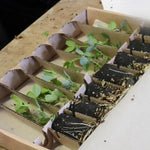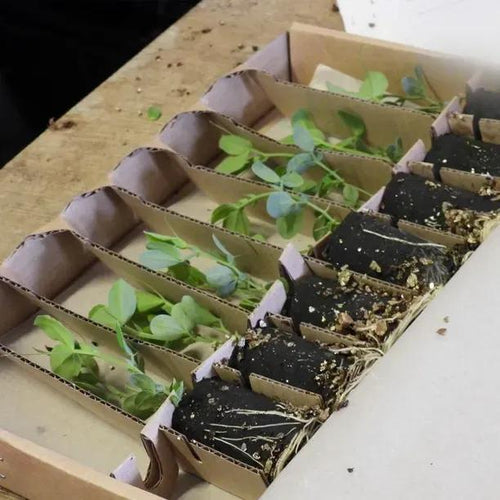Henry Thomas Sweet Pea Plants
A relatively new variety, sweet pea Henry Thomas has rewritten the book when it comes to dark and vividly coloured blooms. Have a look at our range of sweet pea seedlings.
Our Sweet Peas are delivered in purpose-designed, recycled cardboard packaging, and are ready to be planted out when you get them.
We generally send them out between March and May, but we will email you with the likely delivery timescale once you have placed your order.
Unfortunately, lots of deep-hued sweet pea varieties don't stand up well to bad weather, marking in rain especially. Luckily, this rich, luscious, sultry deep crimson-red sweet pea will cope with whatever the British weather has to throw at it and still keeps looking good - no more rain spots!
The large, velvety blooms have beautifully frilled petals, typical of the Spencer varieties, held on strong stems. They look beautiful as a posy in a simple glass vase against a dark background, so you can appreciate the intensity of the flowers.
Garden Design Ideas
Henry Thomas's rain-resistant properties means that people living in areas of heavy rainfall can now grow a sweet pea that won't be ruined by the weather. Its beautiful, glowing crimson colour will marry well with other paler sweet peas with a hint of pink, such as Pink Pearl.
It'll also sit well within a hot-coloured exotic border or arrangement, alongside purple-leaved and orange-flowered cannas, daylilies (Hemerocallis) and large-leaved tender perennials, such as bananas and gingers.
On a more traditional note, let sweet pea Henry Thomas clamber up a trellis alongside repeat-flowering climbing roses, or combine it with tropical climbers, such as Spanish flag (Ipomoea lobata), the cup and saucer vine (Cobaea scandens), passion flower (Passiflora) or morning glory (Ipomoea purpurea).
Features
- Colour: Bright crimson-red
- Stem: Long and sturdy
- Height: Up to 1.8m
- Scent: Medium perfume
- Flowering: June to September
- Planting Months: March-June
- Type: Spencer variety
History & Trivia
Henry Thomas was bred in the UK by Derek Heathcote of Eagle Sweet Peas in 2012 and is named after his grandson.

 Secure, One-Tap Checkout
Secure, One-Tap Checkout
 Hand Picked, Delivered to Your Door!
Hand Picked, Delivered to Your Door! 1 Year Bareroot Guarantee
1 Year Bareroot Guarantee




